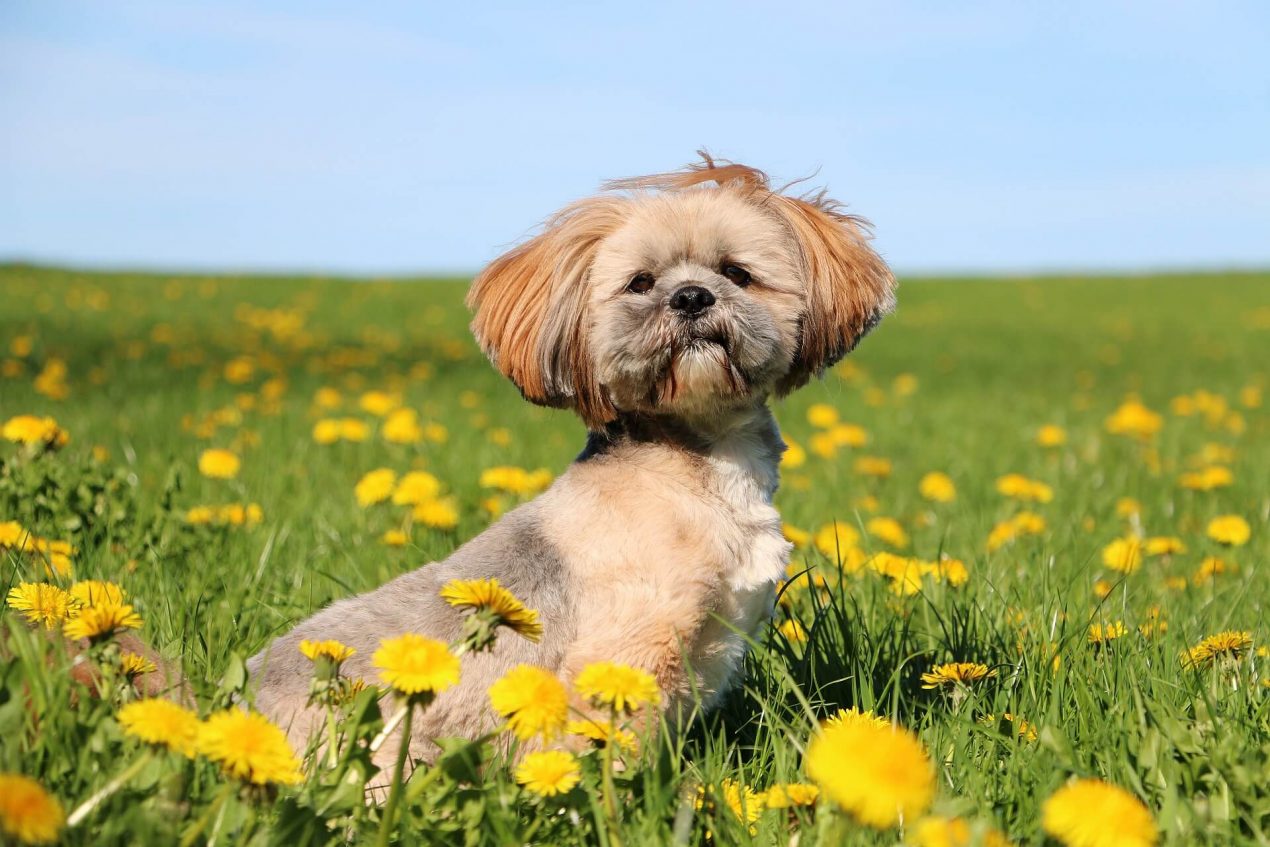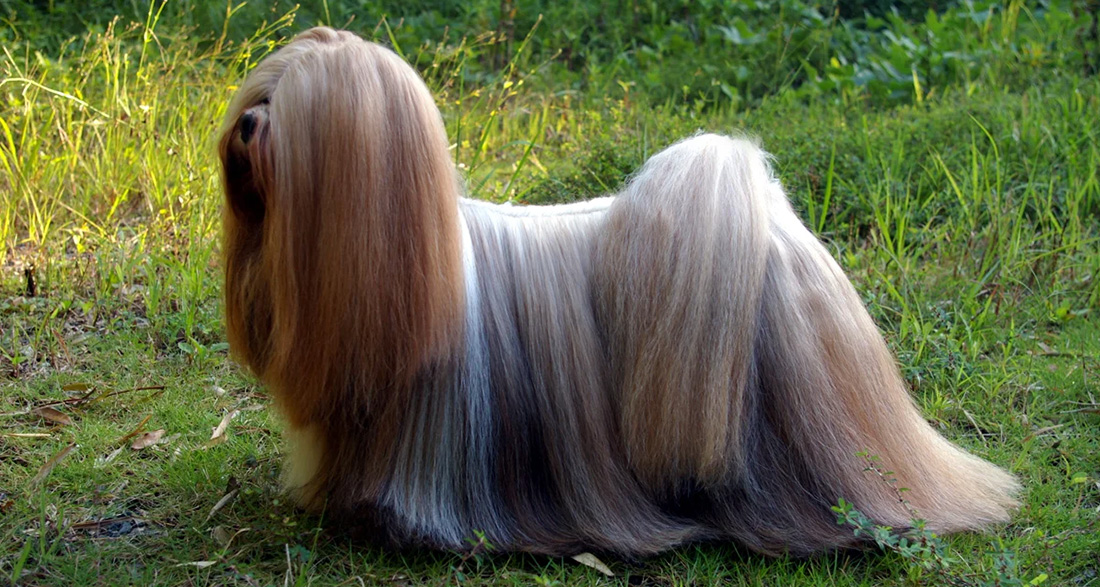The Lhasa Apso is a dog breed from Tibet. The FCI (Fédération Cynologique Internationale) has registered this breed under Standard No. 227, Group 9 – Social and Companion Dogs, Section 5 – Tibetan Dog Breeds. Special feature: The stud book is kept in Great Britain.
History of the Lhasa Apso
The Tibetan Lhasa Apso has an impressive history. For over 2000 years, such dogs have been bred in Tibet and northern India. Especially the Buddhist monks (Lamas) had a special relationship with these dogs. They referred to them as “ambassadors of peace and happiness.” In their belief system, the Lhasa Apso embodied the reincarnation of some deceased brethren. Those were denied access to the “oriental paradise of bliss.” The task of these “sacred” dogs was to guard the treasures of Buddha.
It was frowned upon to sell these dogs; they were given as gifts. This led them to various princely houses and to the Chinese imperial court in Beijing. In their new Chinese home, they were called Shi-tzu-kou, which translates to “dog coming from Tibet.” The high esteem of this dog in its Tibetan homeland is also evident through its name. Lhasa is the capital of Tibet. The addition “Apso” describes its appearance: cuddly, shaggy, long-haired. The common term “lion dog” refers to its mane, reminiscent of a lion.
During the colonial era, the English brought the first specimens to their homeland in 1901. Additionally, the Lhasa Apso was sent to England as a personal token of appreciation from the Dalai Lama. Since then, this breed has been bred in England. In 1933, the first Lhasa Apso breed club was founded in the British Isles. A year later (1934), the breed standard was established. Years later (1960), this breed was recognized by the FCI. It wasn’t until the 1940s that breeding of this Tibetan breed began in the United States. Despite numerous fans of this special breed, the Lhasa Apso is rather rare in the United States. The annual number of registered puppies fluctuates between 50 and 130.
Breed Overview
GROUP: Non-sporting
HEIGHT: 10 to 11 inches (male), slightly smaller (female)
WEIGHT: 12 to 18 pounds
TEMPERAMENT: Alert, affectionate, intelligent
COAT: Long, silky
COLOR: Black, black and tan, cream, golden, grizzle, red, red gold, or white with/without white markings, black tips, brindle, sable, black mask with tips, or parti-color
HYPOALLERGENIC: Yes
LIFE SPAN: 12 to 15 years
Nature and Character
The Lhasa Apso’s character is characterized by temperament, self-confidence, and intelligence. This combination sometimes leads to a certain stubbornness, which can be well managed with consistency. This lively and playful housemate loves close contact with its family and is affectionate. If you’re looking for a lap dog, the Lhasa Apso breed is not the right choice.
This active dog requires a lot of exercise and activity. Despite its friendly nature, it is often reserved around strangers. Additionally, it tends to protect its family and is vigilant, independently “reporting” any incidents. If you meet the needs of this lively dog, you’ll get a balanced companion.
| Affection Level | High |
| Friendliness | Medium |
| Kid-Friendly | Medium |
| Pet-Friendly | Medium |
| Exercise Needs | Medium |
| Playfulness | Medium |
| Energy Level | Medium |
| Trainability | Medium |
| Intelligence | High |
| Tendency to Bark | Medium |
| Amount of Shedding | Low |
Health and Grooming
Lhasa Apso dogs are not prone to diseases. They are considered robust dogs. Occasionally, they may suffer from HD (hip dysplasia) or patellar luxation (kneecap issues). Various eye diseases are also possible. Responsible breeders avoid mating with parents predisposed to these conditions. Despite their beautiful coat, grooming requirements are not particularly high. Regular brushing prevents matting.
The time required is limited to 2 days a week. During shedding seasons, you should brush more often. Especially because of the dense undercoat, daily brushing is beneficial during these times. It’s also wise to regularly trim the fur in the facial area (around the eyes). This haircut gives the Lhasa Apso “clear vision.” The length of the topcoat should not restrict the dog’s mobility.

Acquisition of a Lhasa Apso
Reputable Lhasa Apso breeders are registered with a dog association. For example, the AKC (American Kennel Club) is often willing to provide you with a breeder in your vicinity. Additionally, these associations are informed about the current status of litters. Moreover, you can obtain detailed information about the Lhasa Apso in your federal state from such associations.
What should I consider when buying?
Buying a Lhasa Apso is a matter of trust. Reputable sellers are always willing to present the mother dog with her offspring in their familiar environment. The puppies are typically ready for adoption at around 12 weeks of age. Naturally, they are microchipped. The price of a Lhasa Apso ranges between $1,500 and $2,000. A reputable breeder ensures that their puppies receive veterinary care (vaccination, deworming) and can provide documentation through a pet passport.
Development and training of the puppy
Lhasa Apso puppies should be socialized and trained early on. Puppy courses offer professional support. Loving consistency is important for novice dog owners. This confident breed takes advantage of inconsistency and negligence. Consequently, a cute puppy or young dog can quickly become presumptuous. Despite its independence, it is trainable.
How do I care for a Lhasa Apso?
The Lhasa Apso can be easily kept in a city apartment. Ideally, you live near a park where you can take your daily walks. Joint stress should be minimized through stair climbing. An elevator would be beneficial. With this “lightweight,” you can also carry him upstairs. While a house with a garden is recommended, it is not a prerequisite for a “happy” Lhasa Apso.
Activities with the Lhasa Apso
The Lhasa Apso is very lively. He requires long walks in all weather conditions. You can do anything with your dog that he enjoys. The only condition is not to overexert him. For example, cycling: Do not let your four-legged friend run alongside, but put him in a bicycle basket. New experiences and the closeness of “his” human are the ideal leisure activities. Some disciplines of dog sports are also suitable for small dogs. Together, find the right activity for you (for example, agility or nose work).

Interesting and Worth Knowing
The Lhasa Apso is a long-haired breed. Numerous pictures on the internet cause confusion. A Lhasa Apso short-haired breed is not noted in the breed profile of breeding associations. The different hair lengths are due to maintenance. This floor-length mane is only suitable for show dogs, which lead a very sheltered life. For a lively and balanced dog life, this is only hindering.
Puppies and young dogs initially have short hair. Further hair growth is individual genetic. Some individuals never reach floor-length fur throughout their lives. A short haircut by a dog groomer greatly facilitates the life of a Lhasa Apso in most cases. Additionally, the clever appearance through a short haircut emphasizes the character of this breed.
Do you also have a Lhasa Apso or are you planning to get one soon? Tell me more in the comments!


